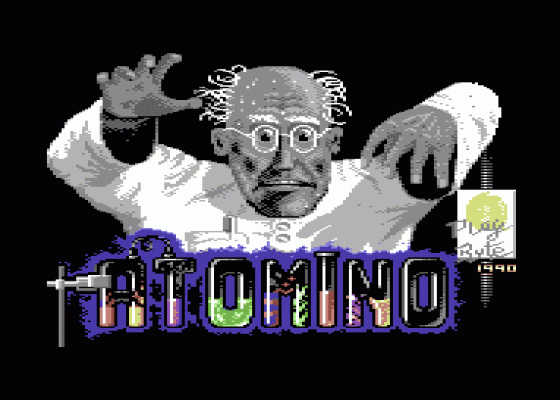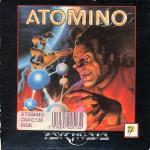
Commodore Format
 1st May 1991
1st May 1991
Categories: Review: Software
Publisher: Psygnosis
Machine: Commodore 64/128
Published in Commodore Format #8
Atomino (Psygnosis)
CF delves into some nuclear DIY and finds that the bonding process is never easy, especially when you've got free electrons who only go off in pairs. Today's review is brought to you by H, O, N and C. Oh, and SJ too...
You're probably thinking, "ooh, this sounds like a cross between atoms and dominoes". And, of course, you'd be completely wrong. Dominoes are small black tiles with white dots on, while atoms are invisible to the naked eye. So don't be stupid.
No, Atomino is a puzzle game based heavily on those large, coloured polystyrene molecules that you play with in chemistry class (you know, the ones that always end up looking like a cross between Mickey Mouse and the Starship Enterprise).

Anyone with the slightest knowledge of things really, really small will be familiar with atoms and their bonding electrons. For the sake of this game, consider an atomic bond as two electrons linked together. In Atomino, there are four types of atom based (pretty loosely) on Hydrogen, Oxygen, Nitrogen and Carbon. H has one free electron, O has two free electrons, N has three and O has four. So, to make a complete molecule with no free electrons dangling around, you could have four Hydrogens joined to a single Oxygen. Or a H-O-O-H in a line. Got it?
Well, if chemistry isn't your strong subject, never mind. There are no double or triple bonds or anything complicated like hexagonal benzene rings. It's all blissfully simple, once you get the hang of it.
The aim is to produce molecules with no free electrons. Once the fast atom is in place and there are no free electrons to bond with, the molecule is complete and disappears from view. And that's all there is to it. To make planning a bit easier, there's a cursor on-screen which shows the valence (number of free electrons) of the next atom in line. This is moved around via the joystick, and whenever it sits next to another atom, it shows you what bonds can be made by little sticks in the compass directions. If it looks like a good move, hit fire and the cursor is replaced by the atom in question. The pile on the right drops by one and off you go again.
If an atom appears that would be better placed where there already is one, all you have to do is place the cursor over the molecule-bound atom and press fire. The two atoms swap places and you can then place the second atom as before. However, this doesn't stop the pile from filling up, so it's best not to get too involved with all this swapping malarkey.
Atomino features two game styles: a free-style make-it-up-as-you-go-along where the aim is simply to keep clearing the screen, and one with pre-set targets. Starting with easy tasks like 'make three molecules' it progresses to 'make four molecules with at least nine atoms', starts plonking blocks on screen to get in your way and then adds un-swappable atoms which have to be removed to clear that screen. After every few levels, there's a puzzle round where you have to fill a pre-defined shape exactly with a complete molecule of exactly the same shape!
Thankfully, the programmers (a German crew by the name of Play Byte) have included a password mode where you can start again without having to replay the earlier levels.
And with 600,000 levels (or thereabouts) this proves to be extremely useful, although I wish the passcodes weren't so far apart (moan whinge). As with most puzzle games, the graphics are smart but nothing to write home change the palette mode from subtle browns and oranges to bright reds and yellows!
Sound is rather less impressive and you'll be glad they included an 'FX only' option. Atomino fits snugly into the mould forged by the likes of Tetris, Puzznic and Atomix, but has enough new features and innovative gameplay for it it snugly into your puzzle collection as well. Be warned, though, while it's a testing challenge the gameplay doesn't really alter that much: there's just more of the same, only harder. Still, I played it and enjoyed it; I'm sure you will too.
Good Points
- Intriguing puzzle gameplay proves very addictive right from the outset.
- Graphics are very tidy: the surround is smart and the atoms look nice 'n round.
- Passcode entry system lets you progress without having to replay earlier levels.
- Incredible amount of levels.
- Smooth controls for hassle-free play under pressure.
- Nice array of options with different game styles, colour and sound modes.
- Simple to pick up and play, yet extremely unchallenging.
Bad Points
- Things get too sticky too soon!
- Even with puzzle stages, gameplay suffer from a lack of variety.



